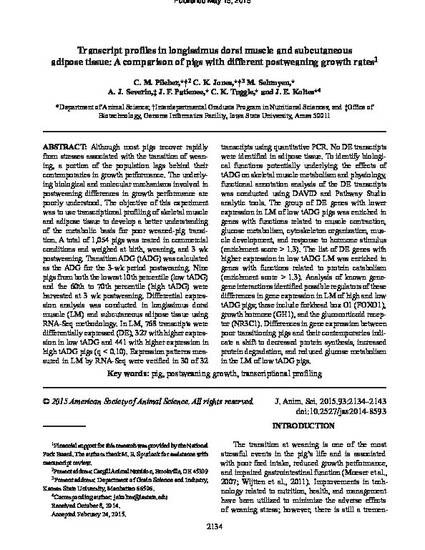
Although most pigs recover rapidly from stresses associated with the transition of weaning, a portion of the population lags behind their contemporaries in growth performance. The underlying biological and molecular mechanisms involved in postweaning differences in growth performance are poorly understood. The objective of this experiment was to use transcriptional profiling of skeletal muscle and adipose tissue to develop a better understanding of the metabolic basis for poor weaned-pig transition. A total of 1,054 pigs was reared in commercial conditions and weighed at birth, weaning, and 3 wk postweaning. Transition ADG (tADG) was calculated as the ADG for the 3-wk period postweaning. Nine pigs from both the lowest 10th percentile (low tADG) and the 60th to 70th percentile (high tADG) were harvested at 3 wk postweaning. Differential expression analysis was conducted in longissimus dorsi muscle (LM) and subcutaneous adipose tissue using RNA-Seq methodology. In LM, 768 transcripts were differentially expressed (DE), 327 with higher expression in low tADG and 441 with higher expression in high tADG pigs (q < 0.10). Expression patterns measured in LM by RNA-Seq were verified in 30 of 32 transcripts using quantitative PCR. No DE transcripts were identified in adipose tissue. To identify biological functions potentially underlying the effects of tADG on skeletal muscle metabolism and physiology, functional annotation analysis of the DE transcripts was conducted using DAVID and Pathway Studio analytic tools. The group of DE genes with lower expression in LM of low tADG pigs was enriched in genes with functions related to muscle contraction, glucose metabolism, cytoskeleton organization, muscle development, and response to hormone stimulus (enrichment score > 1.3). The list of DE genes with higher expression in low tADG LM was enriched in genes with functions related to protein catabolism (enrichment score > 1.3). Analysis of known gene-gene interactions identified possible regulators of these differences in gene expression in LM of high and low tADG pigs; these include forkhead box O1 (FOXO1), growth hormone (GH1), and the glucocorticoid receptor (NR3C1). Differences in gene expression between poor transitioning pigs and their contemporaries indicate a shift to decreased protein synthesis, increased protein degradation, and reduced glucose metabolism in the LM of low tADG pigs.
Available at: http://works.bepress.com/john-patience/5/

This article is from Journal of Animal Science 93 (2015): 2134–2143, doi:10.2527/jas.2014-8593. Posted with permission.